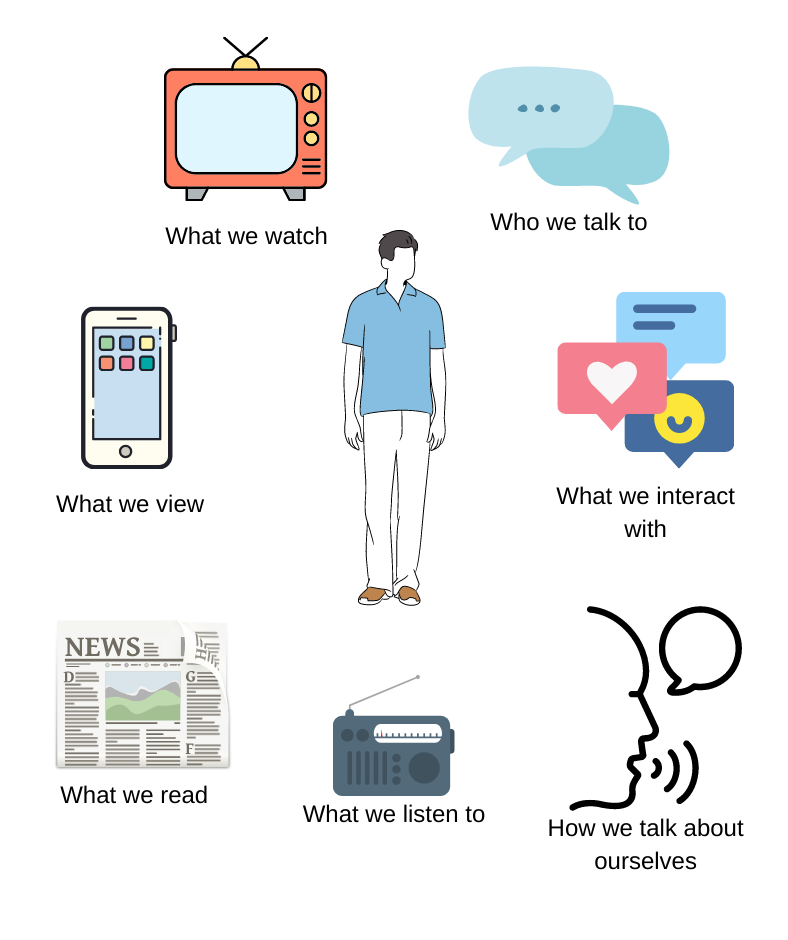The influence of our environment
We often talk about environment, considering nature and the role of sleep and organisation in mental health. However, in this article, I want to instead explore the role environment can have on our belief systems, limiting beliefs and feelings.
Our environment has many components, but for this article, I want to consider our senses:
- What we listen to
- Who we are talking to
- What we are watching
- What we are reading
- What we view
- What we are interacting with
- How we talk about ourselves

- What we listen to – Refers to the input that we gain from our auditory. For instance, through radio, podcasts, television, conversation, opinion etc. What we listen to, even if we do not recognise it at the time, contributes to the way that we feel. If we are predominantly absorbing content which is negative, confrontational, inaccurate or even persistently challenging can have a direct impact on our thoughts, feelings and behaviours.
- Who we are talking to – Taking time to consider the importance of social interactions to our sociable brains is vital. If we spend the majority of time with people who criticise us, talk badly to us, or even only ever share negative experiences with us, this can influence our thoughts and feelings about ourselves. Whilst being a good friend and supporting others are branches of kindness, if our friendships become focused on us only receiving negative input we may need to evaluate our protective factors.
- What we are watching – Referring to what we are taking in visually, through television, electronics, media and films and games. What messaging are we surrounding ourselves with? Research has shown that watching negative news bulletins is directly correlated with increased sense of personal worry (read here) whilst binge watching television was correlated with poorer sleep quality (read here).
- What we are reading – Much as what we are watching, our input through reading whether newspapers, magazines or online influences our mood. One study discussed that ‘when the news was perceived as negative, participants also reported negative emotional states, such as feeling insecure, lonely, anxious, irritated, down, or guilty’ (read here).
- What we view – When we consider the wider range of content available online through apps and services, it perhaps does not surprise that binge watching and extreme input may become detrimental to our well-being. One study looked at the impact of young people absorbing excessive quantities of pornography and found that those absorbing this content ‘reported severe or extremely severe levels of depression, anxiety and stress’ (read here) whilst also exasperating sexism and hostile behaviours (read here) and influencing attitudes to sexuality, relationships and personal identity.
- What we are interacting with – Consider what you interact with everyday through the phone, social media and electronics. How does this interaction influence social relationships, comparisons, mood, school achievements, perspectives and life satisfaction. Research is not yet i depth enough to establish the true correlation between social media use and mental health, but it has been shown to correlate to poor life satisfaction and mood, with moderate correlations to depression and loneliness (read here)
- How we talk about ourselves – Our thoughts are the instructions to our minds. Our brain does not differentiate between whether they are true or not, they do not go looking for evidence. Confirmation bias itself, shows that once we have a belief system we will continually look and accept information which correlates with what our belief is. If a child believes that they are useless, they hear only the negative feedback. Therefore, considering WHAT and HOW we speak to ourselves is paramount to our well-being.
So, what can we do?
Considering how we use this perspective is important. The world does not allow us to just remove all input. However, we can:
- Complete regular audits of our input from different areas and consider where we need to make changes
- Add limitations on our phones and electronics
- Have non-tech days or evenings to reduce input
- Review how frequently we connect with others, and who we are connecting with
- Review who and what we follow online, and evaluate the impact that the messaging has on us and if we need to unfollow it
- Place tech on ‘focus’ mode between certain hours
- Reduce tech use 1-2 hours before bed and consume more light hearted content
- Consider the impact of having the news or radio on when children are in the room
- Create playlists of positive, light hearted music for the trips to school and events, or returning from a heavy day
- Look at the opportunities that children have to be sosicable in relaxed formats
- Consider what we are saying to young people, and whether it focusses on the positive or negative
Want to learn more?
If you want to learn more about mental health strategies you can join our Level 4 training (here).
© Dandelion Training and Development – All Rights Reserved
Further help

For more articles about mental health visit – ARTICLES
To learn more about child and adolescent mental health visit – COURSES
For resources to support child and adolescent mental health visit –RESOURCES
